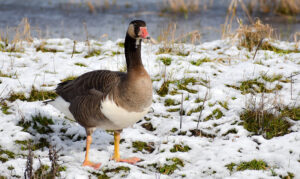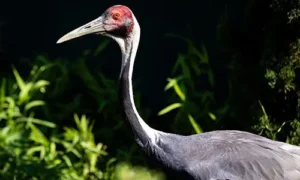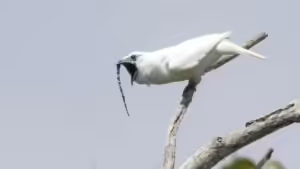Step into the enchanting world of catbirds, where their melodic songs and unique vocalizations will captivate your senses.
These charming birds possess a remarkable talent for imitation, effortlessly mimicking the calls of other birds with astonishing precision.
In every season, their distinctive sounds fill the air, serving as a form of communication with their avian companions.
From their calls for alarm and warning to the joyful melodies that echo through the trees, catbirds have a language all their own.
In this article, we will explore the fascinating world of catbird vocalizations, teaching you how to recognize and appreciate the beauty of their calls.
So, get ready to be serenaded by the melodious tunes of these delightful creatures and discover the hidden language of the catbird call.
Key Takeaways
- Catbirds have a wide range of vocalizations, including melodic songs, mimicry of other bird species, and imitations of sounds like car alarms.
- Their vocalizations are used for communication, establishing territory, attracting mates, and as alarm and warning calls.
- Catbirds have a distinctive raspy song that combines high-pitched whistles, trills, and warbles.
- Recognizing catbird calls requires practice, observation, and comparing them to familiar bird sounds.
Introduction to Catbirds
You may think you know birds, but have you truly experienced the enchanting world of catbirds? These charming creatures are known for their distinctive vocalizations, which set them apart from other birds. Catbirds belong to the Mimidae family, which also includes mockingbirds and thrashers. They are medium-sized birds with gray feathers and a black cap on their heads, making them easily recognizable.
Catbirds are known for their melodious songs, which are a combination of various notes and sounds. They have a wide range of vocalizations, from clear whistles to harsh calls. Their songs are not only beautiful but also serve as a way for them to communicate with other catbirds and establish their territory.
One of the most fascinating things about catbirds is their ability to mimic other birds’ calls. They can imitate the songs of other species, making it challenging for birdwatchers to identify them solely by their vocalizations. This mimicry ability adds to the allure of these birds and makes them a joy to observe.
Next time you are out in nature, listen closely to the melodic tunes of the catbird. Their enchanting songs are sure to captivate you and make you appreciate the unique world of these charming birds.
The Melodic Songs of Catbirds
Listen closely, and you’ll hear their melodic songs filling the air with enchanting tunes. Catbirds are known for their unique vocalizations, which are both beautiful and captivating. Here are three reasons why their songs are truly remarkable:
- Variety: Catbirds have an impressive repertoire of songs that they use to communicate with each other. From soft, melodious trills to sharp, piercing calls, their vocal range is incredibly diverse. Each catbird has its own unique song, making it possible to identify individual birds based on their distinct vocalizations.
- Mimicry: Catbirds are exceptional mimics and can imitate the songs of other birds. They have the ability to mimic the calls of over 50 different bird species, as well as other sounds they encounter in their environment. This mimicry is not only impressive but also serves as a means of defense, as it can confuse predators and protect their nests.
- Emotional expression: Catbirds use their songs to express a range of emotions. They sing when they are happy, content, or excited, and their songs can also convey distress or alarm. Their ability to convey different emotions through their songs adds depth and complexity to their vocalizations, making them even more captivating to listen to.
So, the next time you hear the melodious songs of catbirds, take a moment to appreciate the variety, mimicry, and emotional expression that make their vocalizations truly unique.
Catbirds’ Imitation Skills
Immerse yourself in the enchanting world of catbirds as they showcase their exceptional ability to mimic a wide range of sounds. From the songs of various bird species to the ambient sounds of their surroundings, catbirds possess an uncanny talent for imitation.
It is truly fascinating to witness these charming birds effortlessly mimic the melodic songs of other species, seamlessly blending in with their avian counterparts. Catbirds have been known to imitate the calls of birds such as robins, orioles, and cardinals with remarkable accuracy.
Their repertoire of imitations is not limited to just other birds, however. They can also mimic the sounds made by frogs, squirrels, and even car alarms. This incredible versatility in vocalization allows them to adapt and communicate effectively in their environment.
The purpose of these imitations is not entirely understood, but it is believed that catbirds use this skill to establish territory, attract mates, and communicate with other individuals. By imitating the sounds of other birds or animals, they can create a sense of familiarity and establish themselves as part of the local soundscape.
In short, catbirds’ imitation skills are a testament to their adaptability and intelligence. Their ability to mimic a wide variety of sounds adds depth and complexity to their vocalizations, making them all the more captivating to observe and listen to. So, next time you hear a catbird call, take a moment to appreciate the incredible talent behind that melodic sound.
Unique Vocalizations of Catbirds
Step into the enchanting world of catbirds and let their melodious symphony of sounds transport you to a realm where nature’s chorus comes alive in a captivating dance of echoes and whispers. These charming birds have a unique talent for vocalization, producing a wide range of distinctive calls that set them apart from other avian species.
Here are four examples of the catbird’s vocal repertoire:
- The Mewing Call: This call resembles the meow of a cat, earning the bird its name. It is often used to communicate with other catbirds or to defend its territory.
- The Whistle: Catbirds are excellent mimics, and they can imitate various sounds, including human whistling. This skill adds a touch of musicality to their repertoire.
- The Raspy Song: Catbirds are known for their complex songs, which consist of a medley of different sounds. Their raspy song is a combination of high-pitched whistles, trills, and warbles.
- The Alarm Call: When a catbird senses danger, it emits a loud and piercing call that warns other birds in the vicinity. This helps to protect the flock from potential threats.
In conclusion, the catbird’s unique vocalizations add an enchanting element to the natural symphony of the bird world. By listening to their calls, you can truly appreciate the beauty and diversity of nature’s music.
Catbird Communication with Other Birds
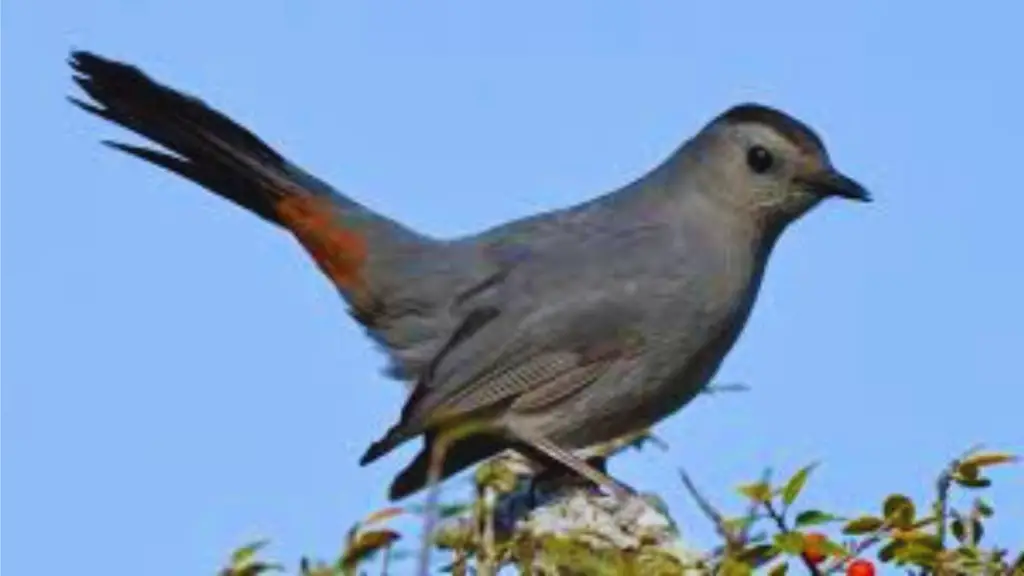
Enter the enchanting world of catbirds and witness their captivating communication with other birds, as they engage in a symphony of whispers and echoes. Catbirds are not only skilled singers but also expert mimics, capable of imitating the calls of various bird species. They use this talent to establish their territory and attract mates. When a catbird encounters another bird, it may engage in a call-and-response interaction, mimicking the other bird’s vocalizations and adding its own unique twist. This exchange creates a mesmerizing duet that echoes through the trees, leaving listeners in awe.
Catbirds are known for their remarkable ability to communicate with a wide range of bird species. They can imitate the songs of warblers, sparrows, and even larger birds like crows. By doing so, they establish a sense of camaraderie and build relationships with other birds. This communication is crucial for survival, as it helps them navigate their environment, locate food sources, and identify potential threats.
To evoke an emotional response in the audience, imagine a visual representation of the catbird’s communication in the form of a table:
| Bird Species | Catbird’s Mimicry |
|---|---|
| Warbler | Melodic trills |
| Sparrow | Whistling tunes |
| Crow | Deep cawing |
| Robin | Cheerful chirps |
| Cardinal | Bold whistles |
As you listen to the catbirds’ symphony of sounds, you can’t help but feel a sense of wonder and appreciation for the intricate language they share with their avian companions.
Catbird Calls as a Form of Territory Defense
Now that you’ve learned about how catbirds communicate with other birds, let’s dive into the fascinating world of catbird calls as a form of territory defense. These charming birds are not only known for their melodious songs but also for their unique vocalizations that serve as a way to protect their territory from intruders.
When a catbird feels its territory is being encroached upon, it will unleash a series of sharp, high-pitched calls that are impossible to ignore. These calls serve as a warning to any potential intruders that they are entering catbird territory and should proceed with caution.
Catbirds are not afraid to defend their territory vigorously, and their calls are often accompanied by aggressive behavior, such as puffing up their feathers and darting towards the intruder. This vocal and physical display is meant to intimidate and drive away any threats to their territory.
It’s truly fascinating to witness the catbird’s instinctual response to protect its home. Their unique vocalizations are a testament to their determination and resilience. So, the next time you hear the distinct catbird call, take a moment to appreciate the lengths these charming birds go to defend their turf.
Catbirds’ Calls during Courtship and Mating
Imagine yourself in the presence of a potential mate as you listen to the captivating and alluring melodies of a catbird’s courtship calls. These charming birds have a unique way of communicating their intentions during the mating season. Here are four fascinating facts about catbirds’ calls during courtship and mating:
- Seductive Serenades: Male catbirds are known for their melodious songs that they use to attract females. These songs are a combination of various notes, whistles, and mimicry of other bird species. It’s like a romantic symphony that can’t be ignored.
- Vocal Dexterity: Catbirds have an impressive vocal range, and they can produce a wide variety of sounds. From soft and sweet melodies to loud and bold calls, they use their vocal dexterity to express their interest and woo their potential partners.
- Duets of Love: During courtship, both male and female catbirds engage in duets where they take turns singing. This synchronized singing not only strengthens their bond but also serves as a way to communicate their commitment to each other.
- Whispers of Intimacy: As the courtship progresses, catbirds often engage in soft, whisper-like calls that are meant for their partner’s ears only. These intimate whispers create a sense of closeness and deepen their connection.
So, next time you find yourself in the presence of a catbird during the mating season, take a moment to appreciate their enchanting courtship calls. It’s nature’s way of bringing love and harmony to the avian world.
Catbirds’ Calls for Alarm and Warning

During times of danger, catbirds emit urgent, high-pitched cries that reverberate through the air, signaling an imminent threat. These calls serve as a warning to other birds in the vicinity, alerting them to potential danger.
When a catbird detects a predator or perceives a threat to its nest or territory, it immediately begins to emit a series of sharp, piercing calls that are impossible to ignore. These alarm calls are distinctive and easily recognizable, allowing other birds to quickly identify the source of the danger.
The urgent nature of the catbird’s alarm calls is evident in their high-pitched and repetitive nature. The calls are meant to grab the attention of other birds and prompt them to take action. In response to the alarm calls, other birds in the area may join in, adding to the volume and intensity of the warning. This collective effort helps to ensure the safety of the catbird and its fellow avian neighbors.
Catbirds are known for their ability to mimic the sounds of other birds, and this talent extends to their alarm calls as well. They can imitate the calls of other species, further enhancing the effectiveness of their warning system. This mimicry not only adds to the overall sense of urgency but also confuses potential predators, making it more difficult for them to locate the source of the alarm.
In conclusion, the catbird’s calls for alarm and warning are essential for the survival of the species. These urgent, high-pitched cries serve as a clear signal of imminent danger, allowing other birds to quickly respond and protect themselves. By emitting these distinctive calls, catbirds are able to communicate effectively and ensure the safety of their fellow avian companions.
Catbirds’ Vocalizations in Different Seasons
Throughout the different seasons, catbirds’ vocalizations vary in tone, pitch, and rhythm, creating a symphony of sounds that reflects the ever-changing natural environment. It’s fascinating how these charming birds adapt their calls to communicate different messages depending on the time of year. Here are three examples of catbirds’ vocalizations in different seasons:
- Spring Serenade: As the weather warms up and breeding season begins, male catbirds unleash a repertoire of melodic songs to attract mates. Their vocalizations are filled with rich tones and complex melodies, showcasing their impressive vocal abilities. These songs serve as a declaration of their territory and a display of their fitness.
- Summer Chatter: During the summer months, catbirds’ vocalizations become more varied and include a mix of high-pitched calls and chattering sounds. They use these vocalizations to communicate with their mates, defend their nesting territory, and warn off potential threats. The rapid rhythm of their calls creates an energetic atmosphere in the summer landscape.
- Autumn Whispers: As fall approaches and the breeding season comes to an end, catbirds’ vocalizations become softer and more subdued. Their calls take on a whisper-like quality, blending seamlessly with the rustling of leaves and the cool breeze. These gentle vocalizations convey a sense of calmness and tranquility, signaling the transition into the quieter season ahead.
In conclusion, catbirds’ vocalizations change with the seasons, adding a dynamic element to the natural world. By listening closely to their symphony of sounds, we can gain a deeper appreciation for the ever-changing beauty of nature.
How to Recognize the Distinctive Sounds of Catbirds
Now that you know about the different vocalizations of catbirds throughout the seasons, let’s dive into how to recognize these distinctive sounds. Listening to catbirds can be an enchanting experience, and with a little practice, you’ll become an expert at identifying their calls. To help you on your journey, I’ve created a handy table that compares the various sounds of catbirds to familiar everyday objects:
| Catbird Sound | Description |
|---|---|
| Mew Call | Similar to the sound of a kitten mewing, this call is soft and high-pitched. It’s often used for communication between catbirds. |
| Song | The catbird’s melodious song is a medley of different notes and phrases. It may remind you of a talented musician playing a variety of instruments. |
| Alarm Call | This call is sharp and loud, resembling the sound of a car alarm going off. Catbirds use it to warn other birds of potential danger. |
| Mimicking | Catbirds are skilled mimics and can imitate the sounds of other birds. They may surprise you with their ability to replicate the songs of different species. |
By familiarizing yourself with these descriptions and spending time listening to catbirds in different contexts, you’ll soon be able to recognize their distinctive sounds with ease. So grab a cup of coffee, head outside, and let the symphony of catbird calls enchant your ears.
Enjoying and Appreciating the Beauty of Catbird Calls
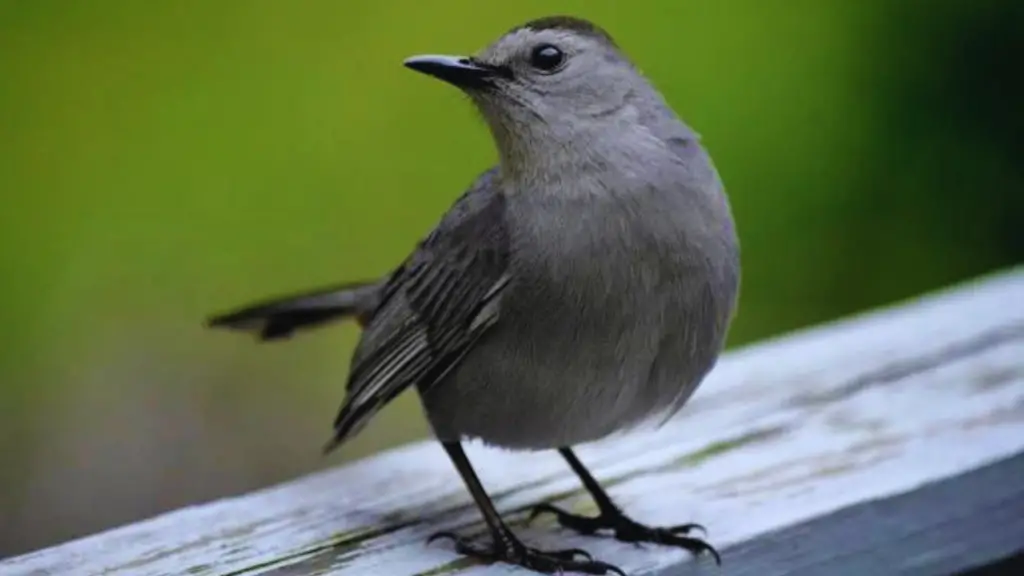
Immerse yourself in the captivating melodies of the catbird’s enchanting symphony, allowing their harmonious tunes to transport you to a world of natural beauty. As you listen to the unique calls of these charming birds, take a moment to appreciate the beauty and complexity of their vocalizations.
The catbird’s calls are a delightful mix of melodic notes, often compared to the sound of a cat’s meow, hence their name.
While each catbird has its own distinct voice, they all share a common trait – the ability to mimic other bird species. As you indulge in their symphony, you might hear snippets of other bird songs woven into their repertoire, adding an extra layer of fascination to their calls. Don’t be surprised if you hear the melodious trills of a robin or the sweet chirping of a sparrow among the catbird’s own unique vocalizations.
Appreciating the beauty of catbird calls also means being attuned to the emotions they convey. These birds use their calls to communicate with each other, expressing joy, fear, or even warning of potential threats. By actively listening to their calls, you can gain insight into their world, understanding their interactions and the stories they tell through their melodies.
So, next time you find yourself in the presence of these charming birds, let yourself be enchanted by their calls. Close your eyes, allow their harmonious tunes to wash over you, and experience the beauty that nature has to offer.
The catbird’s symphony is a gift, a reminder of the incredible diversity and wonder of the natural world.
Catbird Call: Frequently Asked Questions
Are catbirds the only birds that imitate other species’ calls?
No, catbirds are not the only birds that imitate other species’ calls. In fact, many birds have this ability. They use it to communicate, attract mates, and defend their territory. It’s a fascinating skill that adds to the rich tapestry of bird vocalizations.
Do catbirds have a specific call for each type of predator they encounter?
No, catbirds do not have a specific call for each type of predator they encounter. They have a range of alarm calls that they use in response to different threats, but they do not have a specific call for each predator.
How do catbirds communicate with other bird species?
You’re curious about how catbirds communicate with other bird species. They do so by using a variety of vocalizations and body language, allowing them to establish territories, attract mates, and even warn others of potential dangers.
Are catbird calls different during different times of the day?
Yes, catbird calls can vary throughout the day. They may sing more during dawn and dusk, while being quieter during the middle of the day. This behavior is influenced by their feeding and breeding patterns.
Can catbirds imitate human speech?
Yes, catbirds are like the mimics of the bird world! They can imitate human speech, adding a touch of charm to their already delightful repertoire of vocalizations.
Conclusion: Catbird Call
Catbird calls are truly captivating and enchanting. Their melodious tunes transport you to a world of serenity and beauty, like a gentle breeze rustling through the leaves. These charming birds have remarkable imitation skills and unique vocalizations that set them apart. They use their calls to communicate with other birds, warning them of danger and spreading joy in the wilderness. In the spring, their alarm calls serve as a signal to other birds, while in the summer, their harmonious melodies fill the air. Recognizing these distinctive sounds is like unlocking a treasure trove of nature’s symphony. So take a moment to appreciate and enjoy the captivating beauty of catbird calls, a true testament to the wonders of the avian world.




